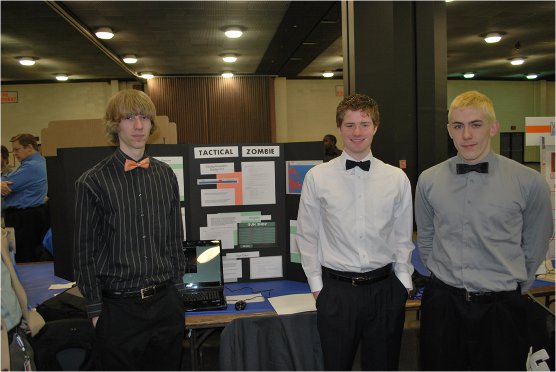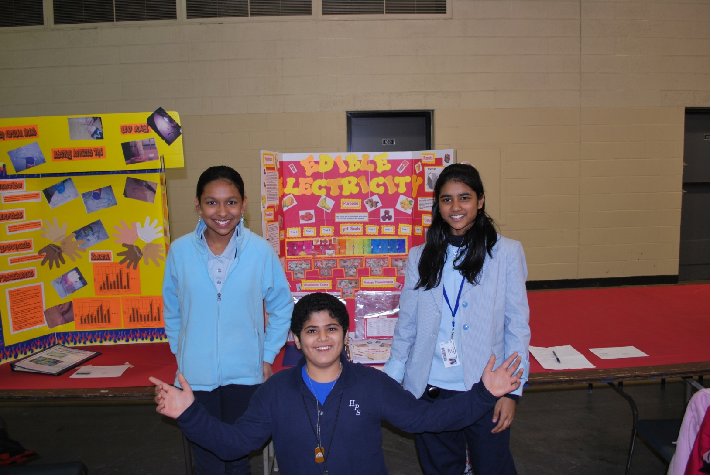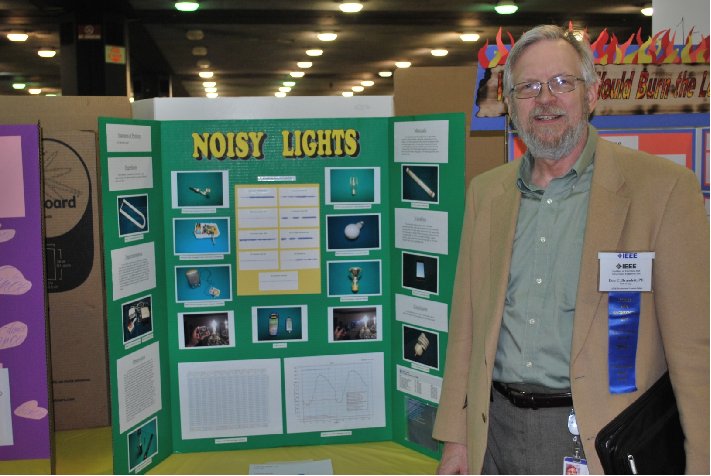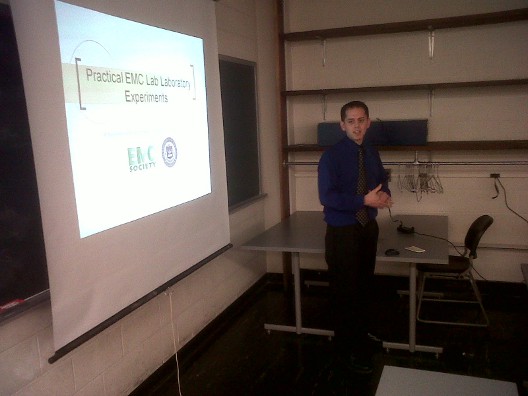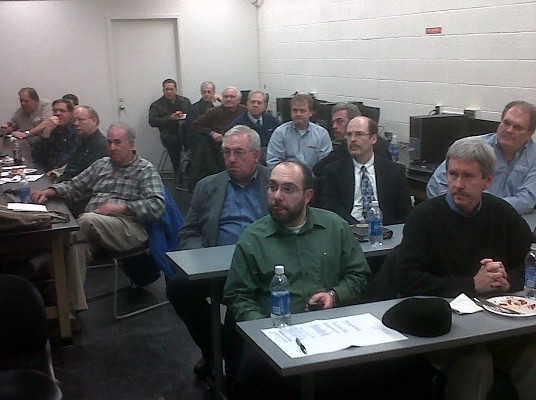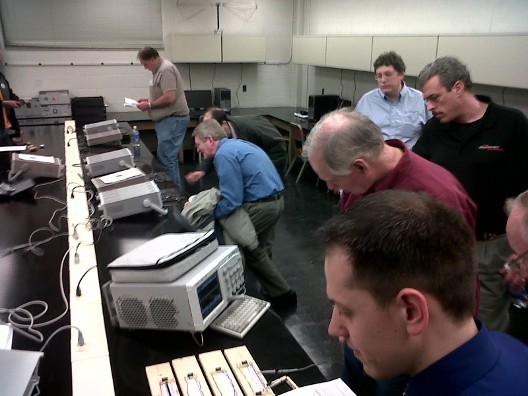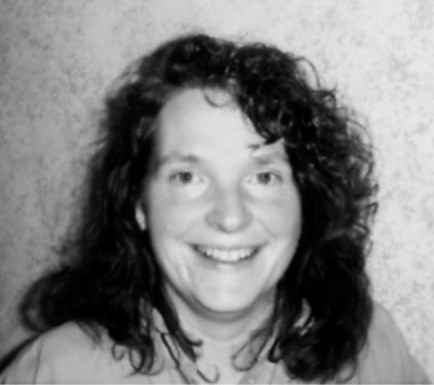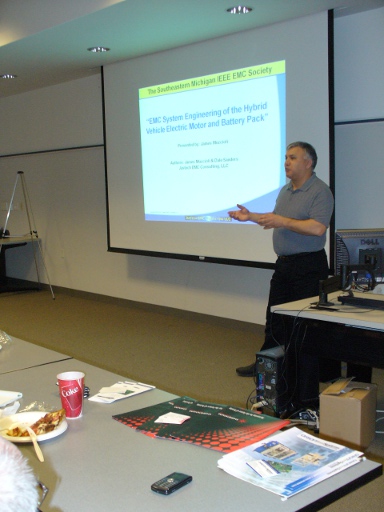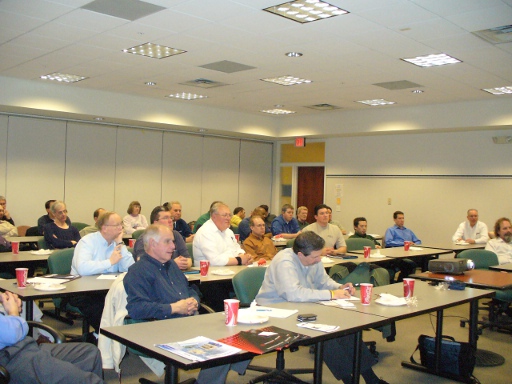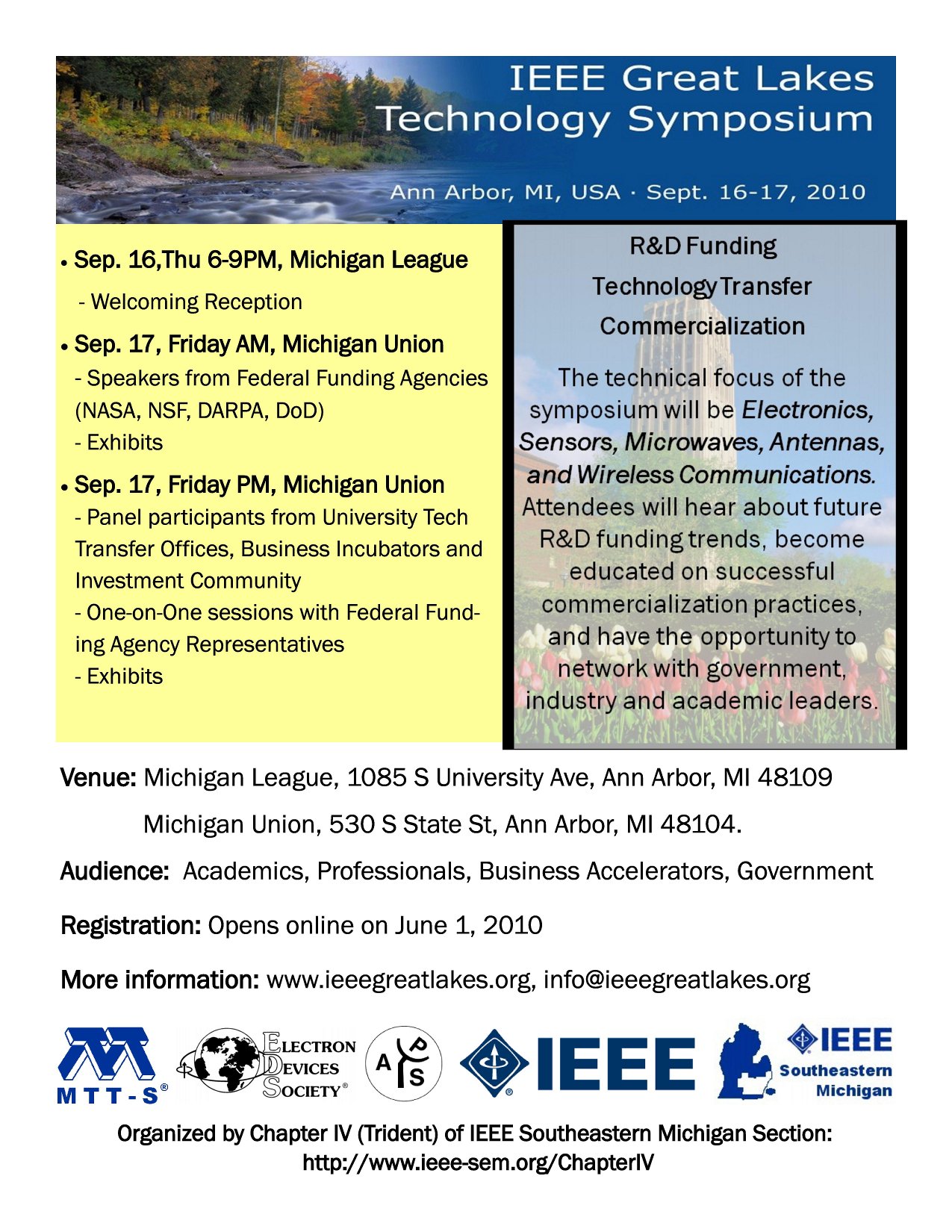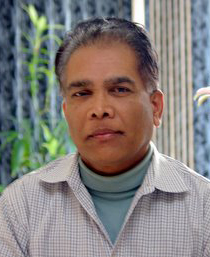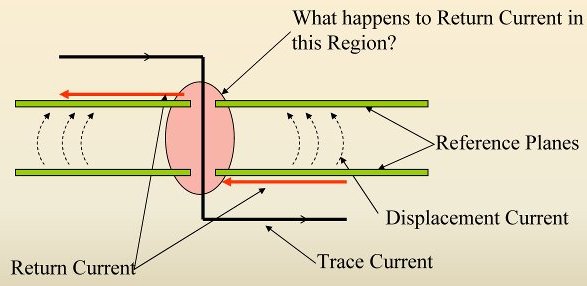 |
Newsletter Home
 May 2010 Issue
May 2010 Issue
In This Issue
Student Science Fair Projects Win IEEE Awards
Volunteer Members Help Judge Student Projects
|
By Don Bramlett, P.E., SMIEEE, Region 4 Director, Section Advisor The 53rd Annual Science and Engineering Fair of Metropolitan Detroit (SEFMD) was held from March 16 through March 19, 2010 in the Michigan Hall of the Cobo Conference Exhibition Center in downtown Detroit. Judging of student projects was performed on Wednesday, March 17. This year the SEFMD had approximately 1200 students participate from Wayne, Oakland and Macomb counties with over 1000 projects on display in two Divisions, the Junior Division (6th thru 8th grade students) and the Senior Division (9th thru 12th grade students). Exhibits were classified into 13 general categories for judging; including engineering, computer science, physics, and environmental science.
The Section wishes to thank the seven (7) IEEE members, and their companies / institutions, for taking the time to volunteer and help to make the Science Fair a more pleasurable and meaningful experience for the middle school and high school students who participated. The IEEE-SEM judging team was composed of five (5) volunteers (see photo). Other IEEE/SEM Section members served in other capacities at the SEFMD, such as: Paul Ostrowski, Ph.D, CCE, SMIEEE (General Category {Life Science} Judge Coordinator) Wayne State Univ Dave Morris, Ph.D. (General Category (Physics) Judge) Mitre The judges had the opportunity to view and evaluate a number of exhibits, especially some interesting projects in areas pertinent to IEEE fields of interest. The judges and the high school students in the Senior Division Team Projects members in the Junior Division had the pleasure to interface and discuss in depth some of the principles, scientific techniques, engineering approach, experimental results and applications pertinent to the projects. The IEEE-SEM Section, based on the evaluations of the panel of judges, awarded two (2) First Place Grand Awards, consisting of a personalized certificate and a cash award for each awardee. We presented these awards to the following Senior Division projects: Mariam Mohamed, a Senior at Dearborn Center for Mathematics, Science and Technology in Dearborn Heights, for her project entitled "Stimulating Protein Synthesis Using Java Applets" Collin Kapppauf, Ian Devins and Artur Ludscher, Seniors at Dearborn Center for Mathematics, Science and Technology in Dearborn Heights, for their project entitled "Tachical Zombie" (A Java GUI Application)
The panel of judges also determined that the IEEE-SEM Section would provide three (3) Honorable Mention Awards to other noteworthy projects in the Junior Division. Each Honorable Mention Award consisted of a personalized certificate each awardee. These awards was presented to: Tazia Miah, Asseel Shammakh and Jenny Ghose, in the 7th Grade at Kosciuszko Middle School in Hamtramck, for their project entitled "Edible Electricity" (A very energetic, outgoing group of students)
Damyan Farion, in the 7th Grade at Immaculate Conception Ukranian Catholic Academy in Warren, for his project entitled "Noisy Lights" Christopher Morris, in the 8th Grade at Our Lady of Good Counsel School in Plymouth, for his project entitled "Which of the Following has More Data Track spacing, the CD or the DVD?" For further information on the Science Fair judging, awards and project abstracts go to www.sefmd.org . The IEEE/SEM Section plans to continue to staff other panels of special awards judges at both the Michigan Regional Future City Competition and the SEFMD in 2011, and in subsequent years. These are just a couple of the pre-university education programs that the IEEE-SEM Section promotes. ·
|
EMC Hands-On Lab Session
|
By Candace Suriano, Ph.D. Christopher Semanson voluntarily developed a series of invaluable and interesting labs to compliment Mark Steffka's undergraduate EMC class at University of Michigan-Dearborn using the EMC Laboratory Manual. On February 18th, 2010, Chris presented the Southeastern Michigan EMC Society chapter with an awesome talk and demos. Chris first gave us an overall understanding of the labs and their utility to understanding EMC. He strategically introduced the labs so that each lab built on the theory learned in the previous labs. Next, Chris took us to a room where he had all the labs set up. We were allowed to enjoy interacting with the demonstrations used in the labs.
Editorial note: Thank you to Scott Lytle, EMC Society Chapter Chair for forwarding this article. The EMC Chapter web site is at https://www.emcsociety.org, Scott can be reached at scott@emcsociety.org. |
Michigan Regional Future City Competition
IEEE Volunteers Help Judge the Electro-Technology Award
|
By Don Bramlett, P.E., SMIEEE, Region 4 Director, Section Advisor The Future City Competition is held each year in association with the annual Engineers Week, this year the week of February 15-21, 2010. The winners from the 39 regional competitions participated in the finals in Washington D.C. during Engineers Week. The 17th Annual Michigan Regional Future City Competition , coordinated by the Engineering Society of Detroit (ESD) and sponsored by the DTE Energy Foundation , the Ford Motor Company Fund and the Skillman Foundation , was held on Monday, January 25, 2010 at the Rock Financial Showplace in Novi. Teams of students from 21 middle schools in Michigan participated in the Michigan regional competition with their future city design projects this year. Judging of student projects was performed in the morning and early afternoon by a record number of volunteer judges. This is the fifteenth year that IEEE/SEM Section members have served as Mentors/General Category Judges for the regional competition. This is the twelfth year that the IEEE/SEM Section has provided a dedicated special team of volunteer judges to specifically evaluate student projects for attributes associated with electrical, electronic and computer engineering related subjects. The Section sponsors the Electro-Technology Award, intended to recognize the design project that exhibits the best application of the theory and practice of electrical, electronics and computer engineering and related sciences and technologies to promote the sustainable development of the future city.
The IEEE/SEM judging team was composed of the following four (4) volunteers: Don C. Bramlett, PE, SMIEEE, FESD, FMSPE, (also Judging Orientation Coordinator for the Michigan Regional Future City Competition), Detroit Edison (DTE Energy) Laurence G. Dishman, Ph.D., Wayne State University/Eastern Michigan University Charles J. Cohen, Ph.D., Cybernet Systems Corporation David Morris, Ph.D., Mitre Other IEEE/SEM members served in other volunteer capacities: Nasim Chowdhri (General Category Judge), Consultant, Project Management Paul Ostrowski, Ph.D.,CCE, SMIEEE, FESD, (General Category Judge), Wayne State University Kimball Williams, (Best Futuristic Transportation Award Judge), DENSO International America, Inc The judges had the opportunity to view and evaluate some outstanding futuristic design projects; in particular they viewed some very interesting applications of current and predicted technologies pertinent to IEEE-related fields. The judges and the students had the pleasure to interface and discuss in depth some of the design principles applied, problems encountered, and teamwork principles used. The IEEE/SEM team of judges awarded the Electro-Technology Award to the Academy of the Sacred Heart. The Electro-Technology award trophy was presented to the team of three presenting students, accompanied by the teacher and the engineer-mentor at the Awards Ceremony that afternoon. ·
|
Behavior Level Modeling and Systems Engineering Talk
IEEE Fellow Presents EMC Testing Hybrids and Legal Issues
|
By Candace Suriano, Ph.D. Behavior Level Modeling is integral to System Engineering. James P. Muccioli gave a presentation to the Southeastern Michigan Chapter of the EMC Society March 18th 2010 on System Engineering using Behavior Level Modeling. The hour gave us an enticing taste of his longer class given at the University of Michigan. Part of his talk dwelt on the legal ramifications of making sure the modules of a system behave in a test environment and only testing three total systems. With the current lawsuit, the lawyers are arguing that this is not a valid approach. However, if the behavior of a module under duress can be defined, that module's behavior should not change in a system environment. Thus, only a few complete systems need to be tested to arrive at a respectable level of confidence. Jim said however that in the current litigious atmosphere, it will be interesting to see if the lawyers and the engineers prevail who say this method is not valid.
James P. Muccioli is an EMC consultant with Jastech EMC Consulting LLC for the last 25 years and an IEEE Fellow. His presentation was challenging and thought provoking. We look forward to seeing Jim again. ·
Editorial note: Thank you to Scott Lytle, EMC Society Chapter Chair for forwarding this article. The EMC Chapter web site is at https://www.emcsociety.org, Scott can be reached at scott@emcsociety.org.
|
Change - Deal with it!
Professional Development and Career Management
|
By Bala Prasanna, SMIEEE A few days after I had started working at a new company, I went to talk to my manager the lack of progress and potential customer ire on an item for which I had responsibility. The manager struck back: what is your management system to get this done? That jolted me to evaluate my existing flaws and reevaluate my approach to get this job done in the context of my own personal management system. Is there a benchmark and trajectory for progress? Are the people expected to work on this aware of my needs and my priorities? Do they see the big picture I see? Ever since that time, I have made a conscious effort to have a process in place that is able to anticipate and react and guide a job to its conclusion, increasing our chances of success. This process, a personal management system, is different for everyone and for each new situation. As we evolve and grow in our work environment, we wear different hats. We are technologists, managers, accountants and lawyers. Even if we might be predominantly technologists, we can never ignore the need for being managers - the ability to manage events and jobs for expected results. After all, where would we be if we didn't produce results? Consider an investment in training yourself with a management system that is personal to you for your success. We are creatures of our habit. Before the die is cast - before an irrevocable choice in our attitudes and behaviors sets in, we need to be open and flexible to adopting positive and productive habits. For example, if I'm aggressive and I always want to be the "bride at every wedding," I need to step back and learn to be accommodating and offer chances for others to shine. (The reverse is also true!) Suppose I have a habit of being very methodical and I can't come to the table to make decisions before I have every single fact. While there are very few things wrong with this picture, remember that present-day business demands that you must sometimes make value-judgements based on, say, only two-thirds of the facts. Of course, you are judged and rewarded on the judgments and decisions you bring to the table. So, it forces you to be different in your approach and be the beneficiary of this change if you play it right. Bring a sense of urgency to your work place. We all have deadlines. If the business governing practices in leading companies these days any indication, reports are generated at several intervals before the deadline, and you will be on "delinquent lists" if you do not fulfill your responsibilities much before the deadline. Frequently being on these "delinquent lists" tells your manager something about you: something not very flattering. Consider front-ending your job items when and where you can - and make a habit of it! No manager wants to see that they have employees being delinquent, no matter what one's justification might be. As much as we enjoy feeling comfortable and secure in our ways of doing things, today's business climate requires us to embrace change, comply with change, and be an agent of change. It can be frustrating (just think about the justification/proof/accountability questions you are asked these days), but you shouldn't allow yourself to be frustrated. You need to have a game plan for surviving and thriving. So, be prepared for change and welcome it by making a few changes in your habits. Your changes, if handled well, will cause you to break away from old habits and be inventive in your approach for a productive and beneficial career. ·
|
Resume Tips: Five Ways to Grab Employers' Attention
Professional Development and Career Management
|
by Deborah Walker, Certified Career Management Coach With today's level of competition for good jobs your resume has got only one chance to make a great first impression. To be considered for interviews your resume must have that special something that grabs the reader's attention and motivates them to call you. Here are five strategies for transforming a blah document into a WOW resume that will get employers calling you. 1. Keep your focus clear and to the point. The first thing potential employers need to know is what you do and the position you are interested in. In the past job seekers have used an objective statement at the top of their resume to indicate their employment interest. With the lightning speed scanning approach that recruiters take in viewing resumes, a wordy, vague objective statement taking up three or more lines of text just doesn't get the job done. In most cases they don't get read. Instead, write a short, direct professional summery that clearly illustrates your career focus. Your statement should include your profession, how long you've done it and your particular areas of expertise. Something to the effect of: Senior purchasing professions with 10 years' procurement expertise in: strategic sourcing, contract negotiation, financial analysis, strategic planning, leadership, contract law and process improvement. Remember, your resume is not an historical tell-all. To keep your focus clear make sure that everything following in your resume relates to your focus. Leave off extraneous details. 2. Stuff your resume with key words. The more key words you use the more frequently your resume will show up in online searches like LinkedIn, TheLadders and CareerBuilder, etc.. Additionally, employer resume data bases also use key words to query for qualifying candidates. Without appropriate key words your resume will be electronically ignored. Without key words, your resume is being shot off into a black void each time you submit it. A good way to make sure your resume is full of key words is to check it against job postings. Use as many of the key words found in the responsibilities and qualifications sections of job postings. As much as you can, match up your terminology with what you find in job postings. 3. Keep your resume reader-friendly. Nothing gets ignored like a resume full of lengthy blocks of text. No one has time to read through that much information. Resume screeners need to be able to absorb your information quickly. Leave out extraneous details so that key facts show up easily. Separate blocks of text into smaller easy-to-digest snippets of information. Use white space to separate bullet points so that each stand out. Be sure that your font size is readable: nothing smaller than 11 point. 4. Include plenty of accomplishments. If you want to stand out from the crowd you must include accomplishments throughout your resume. Write accomplishments that show how you solve universal problems such as saving time, cutting costs, improving performance and increasing customer satisfaction. Your accomplishments should stand out on your resume in bullets separate from your responsibilities. Don't make the common mistake of combining responsibilities and accomplishments in a long list of bullets. List your responsibilities in a small block of text and your accomplishments in bullet form following. 5. Get your best information on page one. It's true, if you can't grab their attention on page one they won't stick it out to find out the wonderful things you've got on page two or three. This presents a problem for those who experienced their most productive work five or more years back. The solution is to use the hybrid resume format that allows you to create a highlight of accomplishments section at the top of page one of your resume. This area of your resume is reserved for the best examples of your work. The accomplishments you include should illustrate the key transferable skills needed for the position you are interested in. Don't delay in implementing these resume changes. Employers are waiting for you with opportunities for a better career and a better life . Read more career tips and see sample resumes at: www.AlphaAdvantage.com. · About the Author: Deborah Walker is a Certified Career Management Coach at Alpha Advantage. She can be reached at Deb@AlphaAdvantage.com. We thank Randy Stevenson, IEEE Section Chair, for forwarding this article. Editorial note: Thank you to Randy Stevenson, Section Chair, for forwarding this article. He can be reached at rcstevenson@emodsolutions.com. |
Signal Integrity and Current Return Paths
Technical Educational Article
|
By Donald L. Sweeney, Past Chair IEEE EMC Society Chicago Chapter, IEEE EMC Society Past Board Member When designing an electronic system, it is important that it function as intended; this requires an understanding of many aspects of EMC including signal integrity (SI). One of the principal ways we can learn to understand SI is by knowing where our currents are flowing, as they move from one area on the circuit board to another and return. It is always easy to know where the intended signal flows, as it will be contained in the trace you place on a circuit board, but where does the return signal current flow? If you have a ground plane the signal is "expected" to flow under the signal trace, as mirror current, as shown in the Figure1.
Members can get a more detailed understanding of this and other technical concepts in the upcoming 3-day course "EMC By Your Design: An EMC Practical Applications Seminar and Workshop" being held Tues. Oct. 26 through Thurs. Oct. 28, 2010, Hilton Hotel, Northbrook, IL. The course includes: Lecture, discussion and hands-on workshop; two textbooks and large workbook of slides used in class; take-home proprietary EMC design software; free optional design evaluation of your product; Instructors with over 75 years combined engineering experience. For registration contact Carol Gorowski at cgorowski@dlsemc.com or at 847-537-6400. D.L.S. Electronic Systems, Inc., 1250 Peterson, Drive, Wheeling, IL 60090, www.dlsemec.com. · About the Author: Donald L. Sweeney has been teaching for over 30 years, at the University of Wisconsin, Oakton College and independent EMC design seminars. He is a senior EMC Engineer and President of D.L.S. Electronic Systems, Inc. He is a graduate of the Department of Electrical Engineering at the University of Illinois at Urbana and has over 40 years experience in the EMC and electrical engineering fields. Don specializes in EMC, RFI and EMI consulting and testing, and is known worldwide for his problem solving abilities. He has served as a special consultant to the Lawrence Livermore National Laboratory and the Nuclear Regulatory Commission. He is Past Chair of the IEEE Chicago Section EMC Society, founding chairman of U.S. Council of EMC Laboratories (USCEL), served on the board of directors of the IEEE EMC Society for twelve years, and is a NARTE certified EMC Engineer. Contact him at dsweeney@dlsemc.com |
Section Conferences Benefit Members
|
As a local IEEE member, you get to attend interesting technical presentations and network with colleagues twice per year at the Spring and Fall Section Conferences. The Committee puts on these conferences as a benefit for members. The Spring conference, held on April 22, 2010, featured the keynote talk by Dr. Charles W. Wampler, IEEE Fellow, on Humanoid Robots. See the web site at https://ewh.ieee.org/r4/se_michigan/Spring2010. The next conference will be held Thursday, November 4, 2010, 5pm-9pm. For details and advanced technical program, see the web site at https://ewh.ieee.org/r4/se_michigan/Fall2010. |
Calendar of Events
|
|
IEEE Section Officers for 2010
|
|
Take the Survey
|
Congratulations, you have read another issue of Wavelengths Newsletter. Please take a moment to give us feedback by taking our Newsletter survey at https://www.surveymonkey.com/s/8V2GDCZ. |
|
Editorial note: All layout and final PDF file creation was done entirely with open source tools from OpenOffice.org . The original layout file is permanently stored in OpenDocument Format (ODF) odfalliance.org . |

